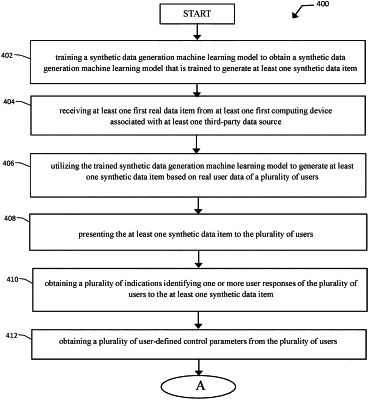| CPC G06F 21/6254 (2013.01) [G06F 18/214 (2023.01); G06F 21/6263 (2013.01); G06N 20/00 (2019.01)] | 20 Claims |

|
1. A method comprising:
training, by one or more processors, a synthetic data generation machine learning model to obtain a trained synthetic data generation machine learning model that is trained to generate at least one synthetic data item, wherein the training is based at least in part on:
i) training user data of a first plurality of users; and
ii) a plurality of training data items from a plurality of third-party data sources;
receiving, by the one or more processors, at least one first real data item from at least one first computing device associated with at least one particular third-party data source;
utilizing, by the one or more processors, the trained synthetic data generation machine learning model to generate at least one user-type specific synthetic data item for at least one user type based at least in part on real user data of a second plurality of users;
presenting, by the one or more processors, the at least one user-type specific synthetic data item at a first visual presentation of an application executing at a plurality of second computing devices associated with the second plurality of users;
obtaining, by the one or more processors, from the plurality of second computing devices, a plurality of indications identifying a plurality of user responses of the second plurality of users to the at least one user-type specific synthetic data item;
obtaining, by one or more processors, one or more user-defined control parameters from the second plurality of users;
configuring, by the one or more processors, a user-defined control mechanism to share at least one portion of the real user data of the second plurality of users based at least in part on the plurality of user-defined control parameters;
obtaining, by the one or more processors, a subset of the real user data based at least in part on the plurality of user-defined control parameters;
providing, by the one or more processors, to the at least one first computing device associated with the at least one particular third-party data source, at least:
i) data regarding the at least one user-type specific synthetic data item,
ii) the at least one portion of the real user data of the second plurality of users; and
iii) the plurality of indications of the second plurality of users;
receiving, by the one or more processors, in response to the providing, at least one second real data item from the at least one first computing device associated with the at least one particular third-party data source; and
presenting, by the one or more processors, the at least one second real data item from the at least one particular third-party data source at a second GUI of the application executing at the plurality of second computing devices associated with the second plurality of users.
|